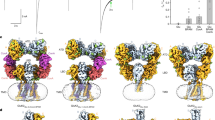Abstract
The Na+, K+-pump controls a wide variety of cellular systems and its inhibition by cardiac glycosides modifies important physiological functions and evokes several pharmacological effects (refs 1, 2 and refs therein). However, not all the actions of cardiac glycosides can be attributed to Na+, K+-pump inhibition and several observations show that, at low doses, cardiac glycosides stimulate the pump3–5. It has been proposed that their positive inotropic effect could be the sum of two processes: the inhibition of the pump and a still unknown additional inotropic mechanism6. In guinea pig heart, low doses of ouabain interact with high-affinity binding sites, which differ from the lower-affinity sites responsible for Na+, K+-pump inhibition3,7–9. It has been suggested that ouabain interaction with these high-affinity sites could be responsible for the additional inotropic mechanism6. The existence of two classes of ouabain-binding sites has been documented not only in guinea pig heart, but also in dog10, rat11,12 and human heart13. Dihydroouabain, a derivative of ouabain in which the lactone ring is saturated, is about 50-fold less potent than ouabain as an inhibitor of Na+, K+-pump and does not stimulate the pump at low doses7. Its inotropic effect can be entirely accounted for by the inhibition of the pump6,14. We have examined the pharmacological action of ouabain in the presence of dihydroouabain and report here that dihydroouabain reduces ouabain inotropic action but not Na+, K+-pump inhibition.
This is a preview of subscription content, access via your institution
Access options
Subscribe to this journal
Receive 51 print issues and online access
$199.00 per year
only $3.90 per issue
Buy this article
- Purchase on Springer Link
- Instant access to full article PDF
Prices may be subject to local taxes which are calculated during checkout
Similar content being viewed by others
References
Bonting, S. L. in Membrane and Ion Transport (ed. Bittar, E. E.) 257–363 (Wiley-Interscience, London, 1970).
Schwartz, A., Lindenmayer, G. E. & Allen, J. C. Pharmac. Rev. 27, 1–134 (1975).
Godfraind, T. & Ghysel-Burton, J. Nature 265, 165–166 (1977).
Langer, G. A. Biochem. Pharmac. 30, 3261–3264 (1981).
Browning, D. J., Guarnieri, T. & Strauss, H. C. J. clin. Invest. 68, 942–956 (1981).
Godfraind, T. & Ghysel-Burton, J. Proc. natn. Acad. Sci. U.S.A. 77, 3067–3069 (1980).
Ghysel-Burton, J. & Godfraind, T. Br. J. Pharmac. 66, 175–184 (1979).
Godfraind, T., De Pover, A. & Tona Lutete, D. Biochem. Pharmac. 29, 1195–1199 (1980).
De Pover, A., Godfraind, T. & Tona Lutete, D. Br. J. Pharmac. 72, P513–P514 (1981).
Wellsmith, N. V. & Lindenmayer, G. E. Circulation Res. 47, 710–720 (1980).
Erdmann, E., Phillipp, G. & Scholz, H. Biochem. Pharmac. 29, 3219–3229 (1980).
Schwartz, A. et al. Proc. 3rd int. Conf. Na, K-ATPase (Academic, New York, in the press).
De Pover, A. & Godfraind, T. Biochem. Pharmac. 28, 3051–3056 (1979).
Lee, C. O., Kang, D. H., Sokol, J. H. & Lee, K. S. Biophys. J. 29, 315–330 (1980).
Pocock, G. J. Physiol., Lond. 307, 38P (1980).
Grupp, G., Grupp, I. L., Ghysel-Burton, J., Godfraind, T. & Schwartz, A. J. Pharmac. exp. Ther. 220, 145–151 (1982).
Clark, A. F., Swanson, P. D. & Stahl, W. L. J. biol. Chem. 250, 9355–9359 (1975).
Thomas, R., Boutagy, J. & Gelbart, A. J. Pharmac. exp. Ther. 191, 219–231 (1974).
Noble, D. Cardiovasc. Res. 14, 495–514 (1980).
Godfraind, T., De Pover, A. & Verbeke, N. Biochim. biophys. Acta 481, 202–211 (1977).
Author information
Authors and Affiliations
Rights and permissions
About this article
Cite this article
Godfraind, T., Ghysel-Burton, J. & Pover, A. Dihydroouabain is an antagonist of ouabain inotropic action. Nature 299, 824–826 (1982). https://doi.org/10.1038/299824a0
Received:
Accepted:
Issue Date:
DOI: https://doi.org/10.1038/299824a0
This article is cited by
-
Dual effect of initial [K] on vascular tone in rat mesenteric arteries
Pflügers Archiv - European Journal of Physiology (2006)
-
In vivo assessment of the inotropic and toxic effects of oxidized ouabain
Basic Research in Cardiology (1993)
Comments
By submitting a comment you agree to abide by our Terms and Community Guidelines. If you find something abusive or that does not comply with our terms or guidelines please flag it as inappropriate.



